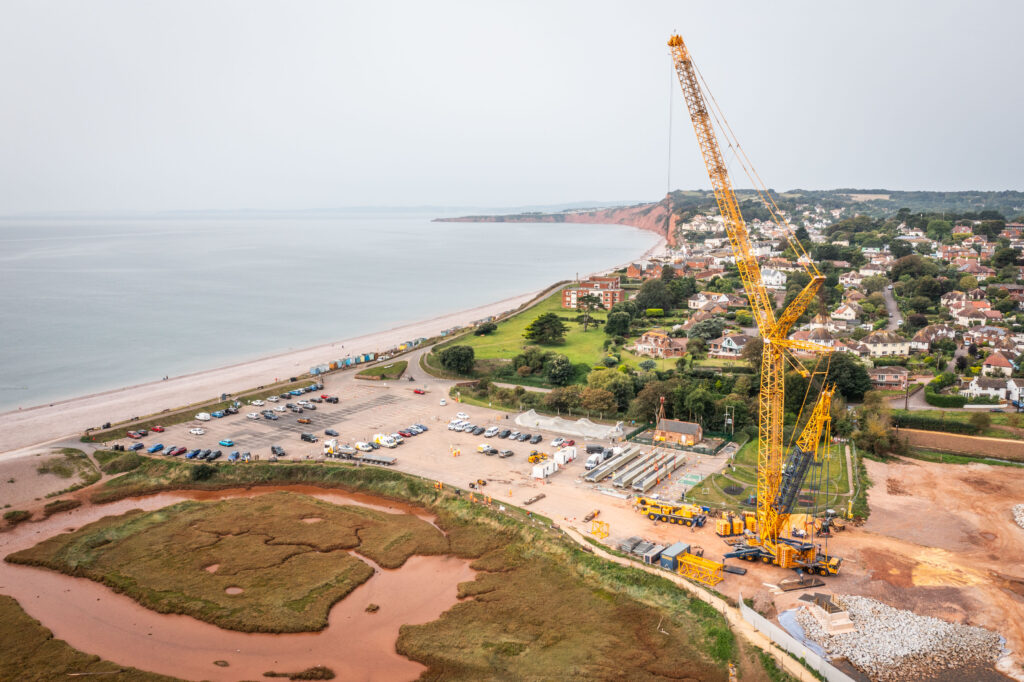One of the biggest coastal climate adaptation and habitat creation projects in England moves a step closer to final completion with the installation of a new 70-metre footbridge.
The Lower Otter Restoration Project (LORP) is a partnership initiative between landowners Clinton Devon Estates and the Environment Agency to restore the historic floodplain of the Otter estuary near Budleigh Salterton, East Devon. The Environment Agency managed the development of the scheme, appointing engineering consultant Jacobs to lead the design of the project and contractor Kier to undertake the construction works. Once construction is complete, the 55 hectare site will be managed by the Pebblebed Heaths Conservation Trust.
Over the last week, a new 70-metre footbridge has been craned into place. Work will now commence to remove 70 metres of embankment, which will allow tides to reach a large part of the Otter estuary for the first time in over 200 years.

Installation of the bridge secures continued access along the South West Coast Path following the connection of the historic floodplain to the Otter estuary (please note the South West Coast path will remain temporarily diverted until the end of October to enable completion of works). This work was initially planned for earlier in the year but was postponed to allow breeding birds (who were flocking to make use of the new habitat) to finish nesting in the area that will flood tidally.
The project has already made a positive difference to the local community. During heavy rain in May, South Farm Road, once notorious for flooding, but which has been raised by the scheme, stayed free of the rising water, allowing local businesses to continue trading and residents to move freely. Budleigh Salterton Cricket Club, whose ground in the past was frequently subject to serious flooding, have been playing this season on a new flood-free pitches created as a result of the project, while a new pavilion for the club is nearing completion.
Dr Sam Bridgewater, Director of Environment Strategy and Evidence at Clinton Devon Estates said: “After more than a decade of planning and hard work, it is fantastic to see the project nearing completion. The benefits for people and the planet are already clear to see. It’s really encouraging that a wide variety of bird species have been visiting the site during the construction phase and we look forward to seeing further wildlife gains as the landscape and habitats develop once the lower valley again becomes tidal as it was two hundred years ago.”

Environment Agency Project Manager Dan Boswell reflected: “Undertaking landscape change of this scale is a huge challenge in terms of engineering, the environment and communication. The efforts of the team to rise to these challenges and deliver a fantastic legacy for the local community as well as improving the environment are to be commended. We are already seeing the positive impact for people and wildlife and that will only increase with time.”
Ecologists working on LORP are confident that habitats developing in the newly restored intertidal zone will increase biodiversity. Mud colonised by invertebrates will provide rich feeding grounds for wading birds like black-tailed godwits, dunlin and redshank, while the warm, shallow waters will also be used by many fish, particularly juveniles. Inter-tidal habitats are also well known for being able to store large amounts of carbon, helping to combat the climate crisis.
Members of the public can already enjoy the improvements and the wildlife they have attracted through 3.3km of improved footpath network that is more resilient to flooding as sea levels rise. Seven new viewing areas have also been constructed to enable visitors to enjoy and learn about the new wildlife have also been built with orientation signs, including a map and information on how to help care for the site.
In addition, unsightly overhead power lines that once ran through the site have been buried on both sides of the Otter valley, putting 2.5km of cables below ground. The work was undertaken in partnership with National Grid and the East Devon Area of Outstanding Natural Beauty.
